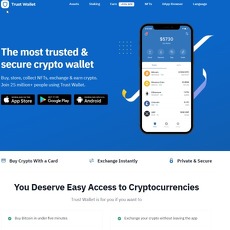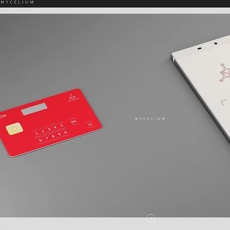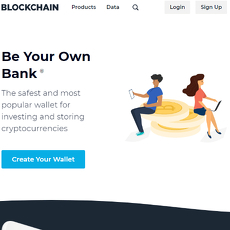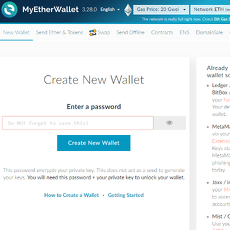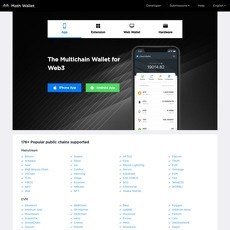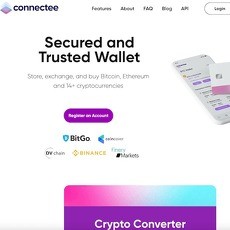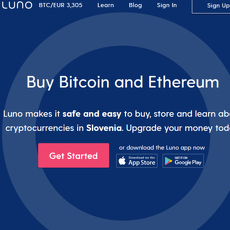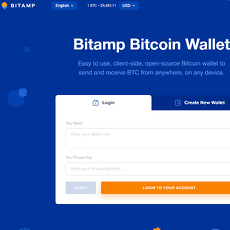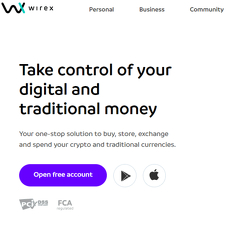Counterparty Wallets Review
Counterparty Wallets
counterparty.io
Counterparty Wallets Review Guide: Everything You Need to Know (With FAQ)
Ever found yourself wide awake, wondering, “Is my crypto really safe in this wallet?” We’ve all heard the stories—lost keys, hacked wallets, and folks who lost it all because of one simple mistake. But what if you could crack this without getting lost in crypto jargon or spending hours comparing options that all seem the same? That’s exactly what I’m going to help with here.
Why Choosing the Right Crypto Wallet Matters
Let’s be real—if you pick the wrong wallet, your crypto adventure can end before it even really gets going. Whether you’re storing Bitcoin, rare tokens, or planning to dabble in DeFi, your wallet is your frontline defense. Here’s why making the right choice is such a big deal:
- Losses Happen Fast: According to Chainalysis, nearly $3.8 billion was lost to crypto theft in 2022 alone. A huge chunk of that comes down to poor wallet choices.
- It’s Not Just About Safety: If a wallet drives you crazy every time you log in, you probably won’t use it—or worse, you might make mistakes when you do.
- Support and Recovery Matter: Have you ever tried getting help from a wallet provider, and all you got was... silence? Yeah, not all wallets stand behind their users.
All of this is why wallet selection might be one of the most important decisions in your crypto journey. A wallet should help you feel in control, not anxious.
I Promise to Make This Simple and Actionable
If terms like “seed phrase,” “private key,” or “multi-sig” give you flashbacks to that confusing first day using crypto—you’re not alone. I’ve spent years testing literally dozens of wallets so you don’t have to. My promise? No stuffy explanations. I’m going to break down what’s crucial (and what’s just marketing fluff), so you can cut through the noise:
- No tech headaches: Just straight answers
- Honest opinions: What works, what doesn’t
- Real-world tips: Backed by experience, not fluffy buzzwords
Let’s put the power back in your hands—with a wallet that works for your life, not the other way around.
What You’ll Get From This Guide
If you’re tired of articles that sound like high school textbooks or sponsored fluff, you’ll feel right at home here. Here’s what’s coming up next:
- Quick, friendly explanations—no priors required
- FAQs that actually answer your top questions
- Super useful tips, based on what I actually check for in my own crypto life
- Links to must-know wallet basics and comparisons to get you confident in your choice
Crypto wallets shouldn't be something you lose sleep over.
If you’re ready to discover what makes Counterparty wallets special—and whether they could be the right fit for storing your digital assets—stick with me. Ever wondered what sets one crypto wallet apart from another? You’ll find your answer in the next section—don’t miss it!
Quick Intro: What is Counterparty and Why Its Wallets Stand Out
A Short Overview of Counterparty
If you’ve ever wondered, “Can I use Bitcoin for more than just sending and holding?” then Counterparty is probably right up your alley. Picture this: a platform built on top of Bitcoin, using Bitcoin’s incredibly secure blockchain but adding a huge twist—support for custom tokens, decentralized trading, and even digital assets like collectibles or games. It’s like giving Bitcoin superpowers.
Launched in 2014, Counterparty’s claim to fame is being one of the pioneers of asset tokenization. Before most people even heard of NFTs or decentralized exchanges, Counterparty let users create and manage unique tokens directly on the Bitcoin network. The platform carved out a serious niche, powering everything from rare collectible assets like Spells of Genesis cards to quirky experiments like Rare Pepe trading cards. There’s a reason some collectors and developers swear by it: Counterparty actually adds new features to Bitcoin itself, without changing the original blockchain code.
"Security isn’t an option in crypto—it’s the foundation. Counterparty proves what’s possible when you build on proven tech but aren’t afraid to innovate."
Types of Counterparty Wallets
Let’s cut through the noise—when you want to explore the world of Counterparty tokens or assets, you’ll need a wallet that’s up for the job. Counterparty doesn’t take a one-size-fits-all approach; you get a few solid choices, depending on your needs and risk level.
- Counterwallet (Web Wallet): This is Counterparty’s official web wallet, found at counterwallet.io. It runs right in your browser—no installation, no waiting. It’s super accessible and works on any device with internet access. Great for quick-checking balances, managing tokens, or sending/receiving Counterparty assets.
- Freewallet (Web/Desktop): Not to be confused with the multicoin Freewallet, this is a handy open-source web wallet (downloadable as a desktop version too). It’s user-friendly and reliable, and people love it for its simplicity—if you don’t need all the bells and whistles, just easy access, this is a solid pick.
- Rare Pepe Wallet: Got a soft spot for digital collectibles? This quirky wallet was made with Counterparty-powered NFTs in mind—especially the famous Rare Pepes. It doubles as a showcase library and marketplace. Even if you’re not a meme lover, this wallet pushed the boundaries for digital ownership models.
- Mobile and Hardware Options: As of now, direct mobile wallet options remain limited for Counterparty, but integration with existing Bitcoin-compatible wallets (like some advanced Electrum forks) is possible if you’re a bit technical. That’s one thing to keep in mind if you want to manage your assets on the go.
The main source for all official Counterparty wallet options and regular updates is always Counterparty’s wallet page, so check there for trusted downloads and security tips.
What Makes Counterparty Wallets Unique
So, why all the fuss—what actually sets these wallets apart from your everyday crypto wallets?
- Token Creation In-Built: Unlike most wallets, Counterparty wallets let you create, issue, or manage your own custom tokens in minutes. Want to launch your own meme coin or experimental digital art? It’s right there, one click away.
- Decentralized Exchange Access: You can trade tokens directly from wallet interfaces—no need for third-party exchanges or jumping through hoops. This is one of the earliest DEX systems, giving you freedom and control.
- Multi-Asset Support: These wallets don’t just handle BTC—they recognize all Counterparty-based assets. Think gaming tokens, art collectibles, loyalty points, event tickets—you name it.
- Proven Security: Everything operates atop Bitcoin’s battle-hardened blockchain. Studies and anecdotal reports highlight that, despite years of wild experimentation, Counterparty hasn’t had major security incidents from the protocol side.
- Real Community History: Counterparty wallets are at the root of some of the earliest and most famous crypto collectible crazes. If you’ve heard of Rare Pepes, Sarutobi Island, or early blockchain games, there’s a strong chance they used Counterparty.
So, if you ever wanted to get hands-on with crypto assets that are a bit off the beaten path, or crave direct access to minting and trading tokens without leaving the Bitcoin ecosystem, these wallets are built for you.
But here’s where things get even more interesting. Ready to see what daily use actually looks like? Curious about how easy (or tricky) it is to get started with these wallets and which features might really matter for beginners or experienced users? Let’s take a closer look at how they actually work in real life, step-by-step, in the next section…
Main Features and How to Use Counterparty Wallets
Key Features at a Glance
Let’s get right to the good stuff. What do you actually get when you try a Counterparty wallet? You aren’t signing up for just another run-of-the-mill wallet. The magic happens in the extras and simplicity sprinkled throughout the experience.
- Multi-asset support: Counterparty wallets aren’t just for holding bitcoin—they’re built for handling custom tokens, rare digital collectibles, and all the extra assets cooked up on Counterparty.
- Token creation & management: With just a few clicks, you can mint your own token or control smart contracts without needing a computer science degree. A lot of indie tokens and even projects like “Rare Pepe” cards kicked off right here.
- Bitcoin integration: Since every transaction settles on the Bitcoin blockchain, you get a juicy combo: Bitcoin’s legendary security yet access to Counterparty’s flexible extras.
- Easy sending and receiving: Standard stuff—send, receive, check your history—all smooth, with no fuss.
- User-friendly interface: Whether you pick Counterwallet for browser convenience or FreeWallet for desktop comfort, most platforms keep bells and whistles to a minimum so you can get things done fast.
Imagine your wallet not just as a keychain, but more like a Swiss Army knife for your crypto life.
How to Set Up and Get Started
No need to guess what button does what, or stress about setting things up. Here’s how to hit the ground running.
- Pick your wallet: Head to the official Counterparty wallets page, pick from options like Counterwallet, FreeWallet, or Indiesquare (mobile).
- Create your wallet/account: Usually as easy as picking a username and getting a set of twelve recovery words. Remember: write these words down, offline, and never share.
- Backup ASAP: The wallet will walk you through backing up your seed or passphrase—do this before you do anything else! (I’ve seen too many stories of people losing access because they skipped this...) Pro tip: Store a copy with your passport or somewhere super secure.
- Send/receive assets: Once you’ve got your address, it’s a few clicks to send Bitcoin or custom tokens. Most wallets let you scan a QR code for instant transfers.
- Create tokens: Got a killer idea for a meme coin? Use the “Create Asset” feature—just give your token a name and decide how many exist. This is where Counterparty really shines.
"I think there is nothing more freeing than knowing you truly control your assets," as a user once said on the Counterparty forums. You don’t even need to trust anyone else—just yourself and your seed phrase.
Security Features to Look Out For
Let’s be honest—nobody wants to be a victim of a hack or lose their hard-earned coins because of a silly mistake. Counterparty wallets layer on multiple protections, but your actions count just as much.
- Non-custodial design: Only you control your seed phrase—wallet providers cannot move your funds.
- Open-source code: Community-reviewed, so sneaky bugs can’t hide for long. If you’re paranoid (or just curious), you can read the code yourself on GitHub.
- Built on Bitcoin: Every transaction gets recorded on the mother of all blockchains, so tampering isn’t just hard, it’s nearly impossible.
- Optional encryption: Some wallets allow you to encrypt your wallet with an extra password. Even if someone got your device, they’re still one layer away from stealing your coins.
Of course, no system is perfect. You’re the last defense—always keep backups offline, update your software when new versions drop, and never install wallets from weird links.
User Experience and Accessibility
Here’s where most wallets either win your loyalty or land in your “never again” folder. The honest truth? Counterparty wallets are pretty easy to pick up for anyone comfortable online, but they aren’t always as glossy or beginner-friendly as the likes of MetaMask or Trust Wallet. It’s a tradeoff—less marketing flash, more focus on utility.
- Interface: Clean, a bit old-school, but straight to the point. You won’t find a fancy dashboard, just the tools you need.
- Learning curve: If you’ve ever used a bitcoin wallet before, you’ll feel right at home. Complete beginners may want to give themselves an hour to get comfortable, especially if custom tokens excite you.
- Support & community: Resources are mostly DIY, with lots of help from community forums, Reddit, and the official Counterparty Wiki. Real users step up to help you out.
Accessibility? You’re covered across web, desktop, and—yes—mobile with Indiesquare, so you can grab your tokens on the go or settle in on your laptop. Even though the design isn't as shiny as some mainstream wallets, the flexibility and real ownership feel empowering.
“Simple things should be simple, complex things should be possible.”
Ever been burned by complicated apps that lose your money because of a tiny mistake? Counterparty aims to keep you in control—without asking for your trust, just your awareness.
Getting curious about how safe your coins actually are inside Counterparty wallets compared to others? Want to know what extra steps you can take to protect your stash? I’ve heard every worry and covered the truth in the next part—stick around for some answers that could spare you stress (or a big loss).
Common Questions People Ask (And Honest Answers)
Is Counterparty Wallet Safe?
Let’s get real—safety is the #1 thing on everyone’s mind when choosing a crypto wallet. So, is your crypto really safe with Counterparty? In truth, the answer's layered. The main thing that stands out is that most Counterparty wallets are non-custodial—meaning you hold your private keys and only you control your assets. No middleman, no gatekeeper.
But remember this: “Not your keys, not your coins.” That classic saying rings true with any wallet, including Counterparty. If you lose your backup or your passphrase, there’s nobody to call for help—so safety’s down to your habits as much as the tech itself.
- Risk: Counterparty wallets depend on your ability to store backups securely.
- Reliability: You’re using software that’s open-source and well-reviewed, but that also means updates and support aren’t as instant as, say, Coinbase.
- Comparison: Versus browser-based wallets (think MetaMask), Counterparty has no browser extension risks. Versus hardware wallets, it’s less bulletproof, but a solid choice for most users.
“Security doesn’t exist in a product, it exists in behavior.”
What Cryptocurrencies Does Counterparty Support?
This is a biggie. Counterparty wallets are built on top of the Bitcoin blockchain. So yes—you can hold and send regular Bitcoin (BTC). But the party trick? You also get access to all the Counterparty tokens (XCP and custom assets) people create using the Counterparty protocol. That means, beyond BTC and XCP, you could be holding rare digital collectibles, NFTs, or project tokens that no regular Bitcoin wallet could show you.
- Supports: Bitcoin, XCP (Counterparty), all custom Counterparty assets (game tokens, NFTs, etc.)
- Does NOT support: Ethereum, ERC-20 tokens, Dogecoin, or mainstream altcoins
If you need to keep Ethereum, Solana, or other major coins, you’ll need a second wallet.
How Do You Recover or Backup Your Counterparty Wallet?
Losing access to your wallet? Nightmare fuel. With Counterparty, most wallets will ask you to save a backup phrase (sometimes called a seed phrase). This is your golden ticket—don’t skip it!
- Write it down (pen & paper, not digital notes!)
- Store securely—think safe, lockbox, or another creative hiding place
- If you need to recover wallets like FreeWallet or Counterwallet, open the app and use the same backup phrase to restore access
No fancy cloud resets here. If the phrase is gone, so are the funds. I’ve read real stories where years of crypto just vanished—heartbreaking, and totally avoidable.
Can You Use Counterparty Wallets on Mobile?
Not everyone wants to lug around a laptop. Thankfully, you’ve got options! There are Counterparty-compatible wallets for both desktop and mobile. For example, FreeWallet offers iOS and Android support, so you can check your tokens and make trades on the go.
But heads up—a few wallets are desktop-only, so always check compatibility before you start. If being able to check your funds anywhere is make-or-break, you’ll want to pick one with a solid mobile app.
What Are the Fees?
Always check the fine print, right? Here’s the deal with Counterparty wallets:
- No wallet fees: Most wallets are free to use—no subscription or management costs.
- Network fees: You’ll pay standard Bitcoin miner fees when sending assets (including tokens!). These vary—sometimes just a few cents, sometimes a couple bucks, depending on Bitcoin network congestion.
- Token creation fees: Launching your own asset or NFT? There’s a cost in XCP for new asset creation, set by network dynamics.
Nothing sneaky—just the blockchain basics. Pro tip: if the mempool’s jammed (lots of waiting transactions), expect slightly higher costs.
Still with me? Here’s where it gets interesting: there's what makes a wallet secure and useful, but that’s only half the puzzle. What should you actually look for before putting your crypto anywhere—features, usability, security, support—what’s the real checklist? And does Counterparty tick the boxes compared to huge players like MetaMask or Electrum? Keep reading for the practical advice you need to actually make the right choice (and maybe save yourself a future headache).
How to Choose the Best Crypto Wallet (And Where Counterparty Fits)
Main Factors Before You Decide
Choosing a crypto wallet is more than just picking the one with the shiniest website. There are a few things that really matter—think coin support, security, how easily you can use it, the reliability of updates, and those extra features that make your life easier (yes, I’m looking at you, tax tools and fee calculators).
- What coins does it support? If your collection is more diverse than a meme coin portfolio, you'll want a wallet that makes juggling multiple tokens a breeze.
- Security and backups—are there features like multi-factor authentication, or handy options to recover your wallet if your laptop dies? If a wallet can’t answer that, it’s a red flag.
- Accessibility. Are you stuck on desktop, or can you use it anywhere—web, mobile, tablet? Nobody likes being locked out of their own crypto party just because they’re on the move.
- Updates and support. Is the team behind your wallet still around, pushing updates, patching bugs, or answering support questions? Abandoned wallets are a playground for hackers.
- Bonus stuff like built-in exchanges, real-time price charts, tracking tools, and even crypto calculators can turn a simple wallet into a powerful hub.
I always take these points seriously—want proof? Take a look at our big review of the top 36 wallets, where we used these same benchmarks. The differences between wallets—desktop, mobile, hardware, software—can determine if your funds are safe or at risk.
Counterparty vs. Other Popular Wallets
This is the question everyone asks: Is using a Counterparty wallet worth it, or should you stick with something like MetaMask, Electrum, or a hardware wallet like Ledger?
- Counterparty wallets offer something unique: on-chain token creation, asset management, even support for custom digital collectibles, all riding directly on the Bitcoin blockchain. For creators and collectors, that’s a killer feature you won’t find with MetaMask (which is Ethereum-based) or Electrum (designed for Bitcoin only).
- MetaMask is amazing for the Ethereum and EVM crowd, with spinning access to DApps, DeFi, and NFTs—but doesn’t touch Bitcoin or Counterparty assets.
- Electrum is razor-focused on Bitcoin. Its simplicity and security are its strengths, but don’t expect multi-token management or built-in DEX trading.
- Hardware wallets like Ledger? If ultimate security is your goal and you don’t need to move coins every day, these can keep your Bitcoin and ERC-20s locked down. Remember—if you lose the physical device and the backup, your coins are gone for good.
I’ve seen some users mix and match—keeping long-term assets on a hardware wallet, using MetaMask for DeFi, and Counterparty for unique Bitcoin-based assets. No shame in having a crypto “toolbox,” especially with each wallet doing something special.
Resources You Should Bookmark
Let’s face it, crypto moves fast and the best wallet today might be old news tomorrow. That’s why it’s so handy to have go-to resources to stay sharp and make decisions quickly:
If you’re serious about security, usability, and your own peace of mind, you’ll want to dig deeper. I encourage you to read this detailed wallet analysis for a clear, no hype breakdown of every top wallet around.
“Cryptocurrency is slowly establishing itself as a global phenomenon, especially now that it’s become fashionable to own one.”
This quote sums up why picking the right wallet isn’t just for ‘techies’ any more—it’s for anyone who values their digital wealth.
I’ve been down the rabbit hole with all types of wallets—web, mobile, hardware, paper. Each has its fans and its flaws. There’s no single best option for everyone, so it’s worth spending a little time deciding what suits your crypto style.
Here’s a quick challenge: What matters most to you—speed, coin diversity, advanced features, or ironclad security? If you could build your dream wallet, what would it have that none of the current ones do?
I’ll break down specific recommendations for beginners, traders, NFT fans, and hodlers in the next part. Wondering if Counterparty is actually worth your energy or if it’s just hype? Hang with me—the real answer may surprise you.
Final Thoughts, Recommendations & FAQ
My Take: Who Should Use Counterparty Wallets?
Every crypto wallet I review, I ask myself: who would actually get value from this? With Counterparty wallets, the answer is pretty straightforward—if you like experimenting with new tokens, building on Bitcoin, or you’re curious about collectibles like Rare Pepes, it’s totally worth a look. This wallet is a good fit for explorers and tinkerers, not just folks who want to stash and forget their Bitcoin.
Counterparty wallets are awesome for:
- Anyone wanting to create or trade custom tokens (think collectables, digital assets, weird memes—Counterparty’s basically the OG NFT platform)
- People who like self-custody and direct control (no hidden middlemen here)
- Those who want to interact with Bitcoin-based smart contracts, instead of just holding BTC
- Old-school crypto fans who want to see what blockchain was like before things went mainstream
There are easier wallets out there for “just Bitcoin” or ERC-20 tokens. But if you get excited about experimenting and learning new crypto tricks, Counterparty has a lot to offer.
Checklist: Is Counterparty Right For You?
This quick checklist will help you figure it out:
- Are you interested in unique tokens, collectibles, or on-chain games? If yes, Counterparty is a goldmine.
- Do you want to create your own digital assets? You can do that here—all on top of Bitcoin.
- Is open-source and transparency a big deal for you? This wallet passes that test.
- Are you already familiar with hot wallets, backups, and securing your phrase? Good—you’ll have no problems.
- Need lightning-fast transactions or Layer-2, cheap swaps? Counterparty’s based on Bitcoin, so transactions can be slower and pricier than wallets built on other chains. Just something to keep in mind.
Still Got Questions? FAQ
Here are a few more answers so you don’t have to go searching anywhere else:
- Can I use Counterparty wallets with hardware wallets?
Yes. Proxy tools like FreeWallet sometimes support hardware wallet integrations for extra security, but double-check which versions are supported. - What happens if Counterparty disappears?
You still control your seed words and private keys, so you can access your assets with another compatible wallet. This is the beauty of self-custody and open standards. - Is there any mobile wallet?
There have been mobile solutions in the past, but web and desktop remain most reliable for everyday use as of 2024. Always use the official list on counterparty.io/wallets/ to avoid scams. - Can you store ETH or other blockchains’ assets?
No—Counterparty is Bitcoin-only. That means only BTC and assets created on the Counterparty protocol (like XCP, gaming tokens, collectables, etc). - How risky is it?
Like any hot wallet, there’s a trade-off between convenience and security. Have malware protection, never share your phrase, and use the most up-to-date versions. Studies of crypto theft trends (see Chainalysis Crypto Crime Report 2023) consistently find user error and phishing are bigger risks than code bugs, so stay alert.
Wrapping Up—Protect Your Crypto, Choose Smart
No matter which wallet you end up with, remember—security isn’t a set-and-forget thing. Keep your seed phrase backed up in a safe place, never type it online, and always double-check site URLs to dodge phishing scams.
Bottom line? Counterparty wallets are unique and powerful if you love the innovation side of crypto and don’t mind a few extra clicks to get it right. If you just want something simple to hold BTC, it might feel like overkill. But if the idea of building digital art, gaming on-chain, or owning a piece of early crypto history gets you psyched, you’ll be in good company here.
Stay safe out there—crypto is all about taking control, but it’s also about learning and protecting your assets. Smart choices today mean fewer regrets tomorrow.
Want to explore more? Jump into the best crypto wallets list and compare everything side by side. Here’s to confident, secure, and exciting crypto adventures!


